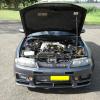R32gtr sputtering and stalling
Announcements
-
Similar Content
-
Latest Posts
-
Duncan:- it affect both sides. Driver side is worse.
-
That seems like a very special issue! Does it affect both sides? Either way, I would disconnect the driver's side switch and see if it still happens, noting that might require removal of the whole door card which is a bit of a pain (it does on V37 and HY51)
-
MBS206:- The windows start to slowly open themselves. GTSBoy:- Battery is new since Dec.
-
I currently have a 2008 370GT Coupe, with the big brakes (Akebeno if I'm correct), and Its coming time to get new pads. Previously, I had a 2003 350GT Coupe with the stock sized brakes, not Brembos. I had custom wheels on it that were pretty open to the brakes, and when I first put the wheels on it, the rims where completely coated with brake dust. A few years after adding the new rims, I needed to change to pads on that car. I didn't do any research, but I told the mechanic of the problem with the brake dust. I also told him I didn't track the car or even drive around the streets harshley. But the dust was an issue. The mechanics changed the pads to a different compound, and the dust was GONE! The other change I noted was that when coming to a complete stop, instead of having to press harder on the pedal as I approached 0kph, I had to actually lift off a little to not come to a hard jerky stop.( My unfounded explanation is they became stickier as they heated by stopping ) Since I got my 370gt with big brakes, I noticed that that as I came closer to stopping, I had to press harder and harder to reach a full stop. I am not talking about hard, just harder. I brought the car in from another state, so when I had a blue slip done, I asked the mechanic what he thought of the brakes, and he thought they were brilliant. The only negative of these pads on the 350GT, was that they squealed when cold. So driving out of a shopping center carpark, it was a little embarrassing, as the brakes squealed, and I am sure people thought that I needed new brakes, when they were actually fresh. I have no idea of what type of compound they were on the 350gt, but whatever it was, I want to get the exact same on my 370GT. They weren't ridiculously expensive, and were replaced at the local JAX (which is no longer open), so I am certain they would be a pretty common big brand, off the shelf type/brand. My current mechanic suggested I need top get the rear pads changed soonish, but he suggested standard Brembo pads. Which I expect to behave the same as the current ones and not like the ones on the 350GT. I don't think dust will be an issue on the 370GT. With the behaviour I describe above on the 360GT, does anyone have a suggestion of pad material that will act like the change I had done on the 350GT?
-
The consult isn't even OBD1. It's a Nissan Consult. Proprietary. Re read everything I've said. I specifically say, put down the laptop/tablet. Understand, and review the issue first. Logging voltages is the same as logging the converted value. Things like O2 that you say to log, is unusable for this, whether it be the voltage, or the value the ECU thinks. The fact you don't know how to diagnose without looking at the computer, is exactly what I've said multiple times is the issue for why techs these days can't diagnose the fun issues with cars.
-






Recommended Posts
Create an account or sign in to comment
You need to be a member in order to leave a comment
Create an account
Sign up for a new account in our community. It's easy!
Register a new accountSign in
Already have an account? Sign in here.
Sign In Now